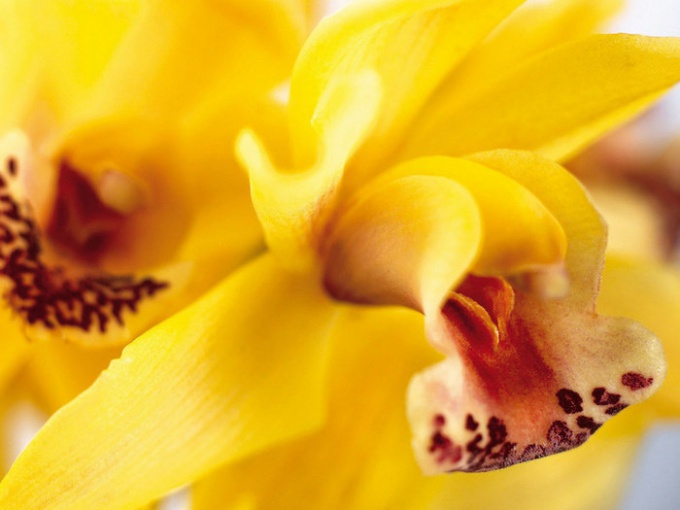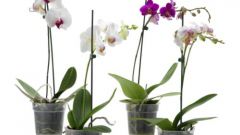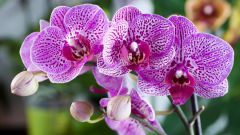Orchid is one of the first places among the demanding overseas plants. However, do not be afraid of its whims. Care of orchids at home – quite a feasible task if you learn the basic rules of growing before you buy a flower.
Care for orchids, like all plants, consists of lighting, watering, fertilizing, transplanting, and ensure appropriate soil.
Care for orchids: lighting
Proper lighting is one of the key factors in growing orchids. This will directly depend on their blooms. If the light is not enough, then the plant will not have enough nutrition to develop. If the lighting is excessive, that flower will burn. During the period of active development of optimal daylength will be 12-15 hours. From November to March, the lack of natural light is needed to compensate for artificial. It is possible to use, for example, fluorescent lamps. When there is insufficient light the leaves get dark Orchid color, but with excessive yellow with brown patches. Thus, to take proper care of orchids can be guided by their appearance.
How to water orchids
Another important factor is watering. In natural conditions orchids are rarely in the water, so they can't stand stagnation. In addition, due to the large diversity of species of orchids, each of them has its own requirements. Care orchids at home must reproduce these natural needs. Also when watering you should consider the air temperature, amount of sunlight, level of humidity and the amount of the pot. For orchids is not as scary dryness as waterlogged. In the first case, the plant will shrivel, and the second will start to darken and rot the roots, which can lead to the death of a flower. Watering the orchids is necessary only in the period of active growth and flowering. The optimum amount of irrigation is 2-3 times a week. To care for orchids in this season of need, based on the degree of dryness of the soil. The water should be room temperature or slightly warm. In winter and in periods after flowering, the entry of moisture should be reduced.
Fertilizing orchids
Caring for orchids includes correct feeding. It should be carried out only in the growing season. With this purpose, strictly specialized tools. In any case it is impossible to fertilize Orchid mixes designed for other colors. A special fertilizer you need to buy in a flower shop and dissolve it in water according to the instructions on the package. Fertilizing is very important for flowering, so during this period, orchids need to fertilize every two weeks.
Soil for orchids, pots
Soil for orchids-epiphytes should consist of bark, charcoal, moss, clay, cork, natural fibers and coarse sand. Such a substrate is characterized by a looseness and inability to preobrazhatsya, which is very important for orchids. The role pot can play baskets and pots made of wire or even mesh. Soil for terrestrial orchids consists of the same substrate for epiphytes, but more crushed and mixed with earth, it will make it hold moisture. Terrestrial orchids it is advisable to put in a simple plastic container with slatted bottom, which will allow water to drain freely after watering. It is desirable that the container was transparent. This will allow you to monitor the root system of the flower. If desired, the container can be placed in a more beautiful pot, or hang a planter.
Care of blooming Orchid
Many people wonder how to care for orchids during flowering. During this period, it is important to give the plant enough moisture, minerals and direct sunlight. It is very important to maintain a high level of humidity around the flower. For this purpose, the leaves and aerial roots should be irrigated with a spray bottle with warm water. If necessary, this procedure should be repeated several times a day, however, to ensure that the flower has had time to dry before night.
Orchids love the humidity level of 60-80%. During this period, the plant needs lots of fresh air. Therefore, proper care of orchids during flowering includes the regular airing of rooms. Orchids like air circulation, but avoid strong drafts. An important factor for good flowering orchids are daily fluctuations in temperature. Optimal daytime temperature is 18-27C and night – 13-24S. Sometimes, plants are accustomed to high temperatures, specially is transferred to a cool place. This stimulates the release of the peduncle.
What to do when the Orchid bloomed
It is also necessary to address the question how to care for orchids after flowering. When the plant withered, and the flower stalk began to wither, no need to immediately cut it. The fact that for a long time after flowering stems to nourish a plant its juices. Only when the stems become completely yellow, you can safely cut it. In General, care of orchids after flowering is quite simple. The need to reduce the entry of moisture and fertilizer. If the plant is transplanted, flowering may not occur for about a year.
Transplant orchids
Transplant orchids to do when the leaves outside of the pot in width. It is desirable to transplant between the stages of active growth. Necessary to carefully extract the plant from the old pot, trying not to injure the roots. Then to remove the roots from the old soil and trim dry or rotten roots. The new container should be two sizes larger than the previous one. Its bottom is filled with fresh substrate, then there would be the Orchid, and the remaining amount posypaetsya soil. Megarave space does not need to stamp the ground. The substrate should be loose. After planting the flower needs a little water and put in a cool place for 3-5 days.





